1987 SUZUKI GRAND VITARA coolant temperature
[x] Cancel search: coolant temperaturePage 165 of 962
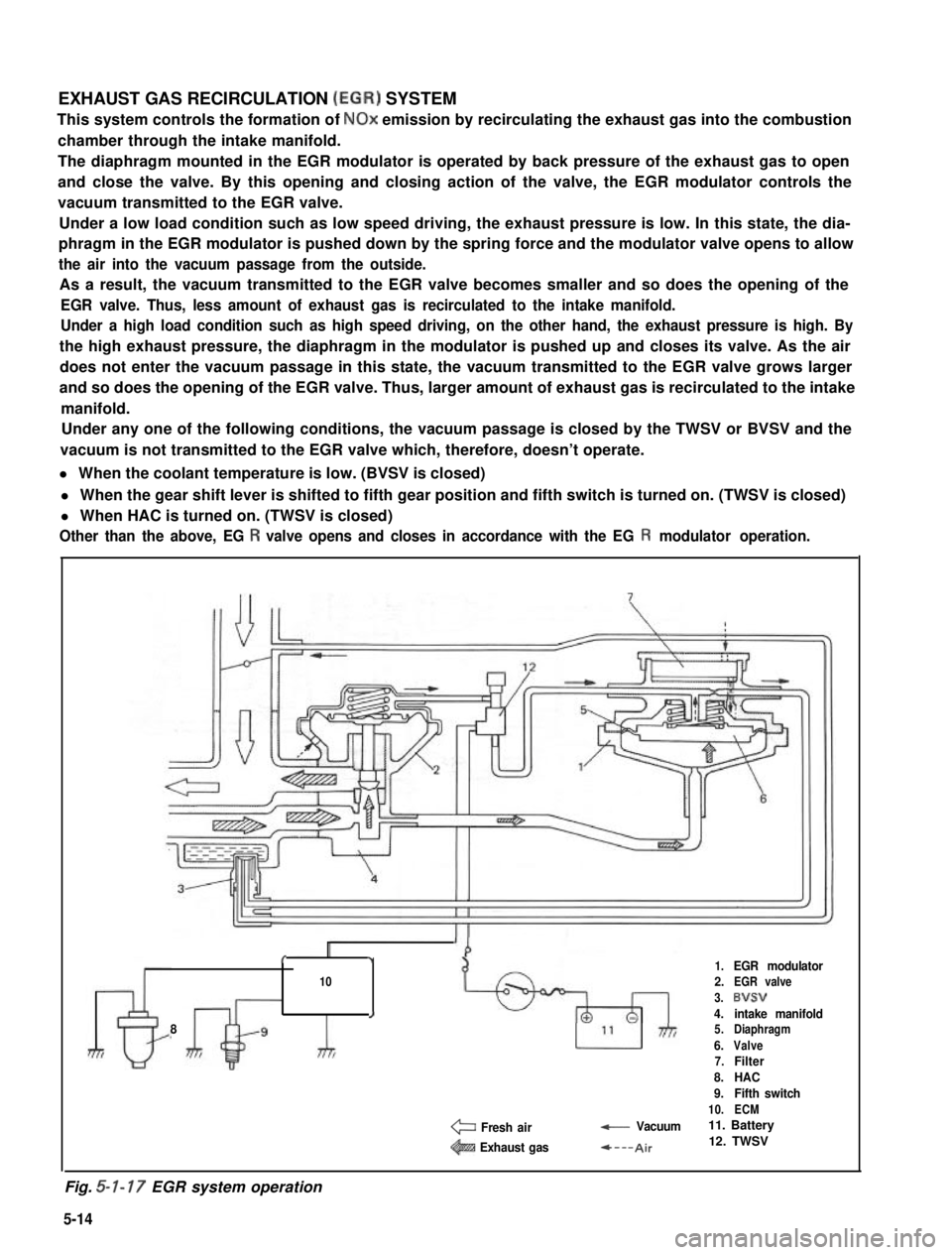
EXHAUST GAS RECIRCULATION (EGR) SYSTEM
This system controls the formation of NOx emission by recirculating the exhaust gas into the combustion
chamber through the intake manifold.
The diaphragm mounted in the EGR modulator is operated by back pressure of the exhaust gas to open
and close the valve. By this opening and closing action of the valve, the EGR modulator controls the
vacuum transmitted to the EGR valve.
Under a low load condition such as low speed driving, the exhaust pressure is low. In this state, the dia-
phragm in the EGR modulator is pushed down by the spring force and the modulator valve opens to allow
the air into the vacuum passage from the outside.
As a result, the vacuum transmitted to the EGR valve becomes smaller and so does the opening of the
EGR valve. Thus, less amount of exhaust gas is recirculated to the intake manifold.
Under a high load condition such as high speed driving, on the other hand, the exhaust pressure is high. By
the high exhaust pressure, the diaphragm in the modulator is pushed up and closes its valve. As the air
does not enter the vacuum passage in this state, the vacuum transmitted to the EGR valve grows larger
and so does the opening of the EGR valve. Thus, larger amount of exhaust gas is recirculated to the intake
manifold.
Under any one of the following conditions, the vacuum passage is closed by the TWSV or BVSV and the
vacuum is not transmitted to the EGR valve which, therefore, doesn’t operate.
l When the coolant temperature is low. (BVSV is closed)
l When the gear shift lever is shifted to fifth gear position and fifth switch is turned on. (TWSV is closed)
l When HAC is turned on. (TWSV is closed)
Other than the above, EG R valve opens and closes in accordance with the EG R modulator operation.
8
c,1.EGR modulator102.EGR valve
3.8VSV
J4.intake manifold5.Diaphragm
6.Valve7.Filter
8.HAC
9.Fifth switch
10.ECM
e Fresh air- Vacuum11. Battery
@!B Exhaust gas*---Air12. TWSV
Fig. 5-l- 17 EGR system operation
5-14
Page 192 of 962
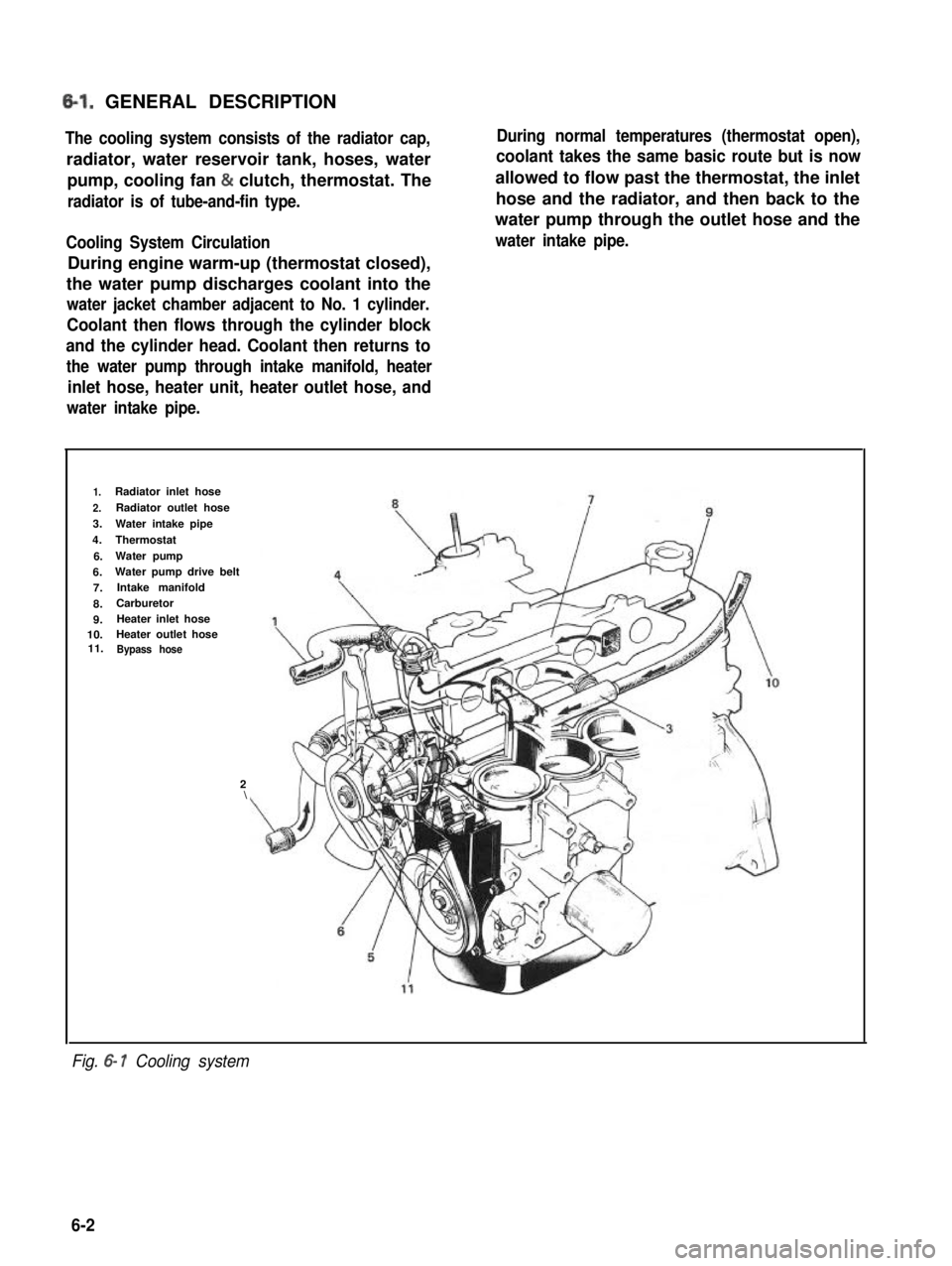
6-l. GENERAL DESCRIPTION
The cooling system consists of the radiator cap,
radiator, water reservoir tank, hoses, water
pump, cooling fan & clutch, thermostat. The
radiator is of tube-and-fin type.
Cooling System Circulation
During engine warm-up (thermostat closed),
the water pump discharges coolant into the
water jacket chamber adjacent to No. 1 cylinder.
Coolant then flows through the cylinder block
and the cylinder head. Coolant then returns to
the water pump through intake manifold, heater
inlet hose, heater unit, heater outlet hose, and
water intake pipe.
During normal temperatures (thermostat open),
coolant takes the same basic route but is now
allowed to flow past the thermostat, the inlet
hose and the radiator, and then back to the
water pump through the outlet hose and the
water intake pipe.
1.Radiator inlet hose
2.Radiator outlet hose
3.Water intake pipe
4.Thermostat
6.Water pump
6.Water pump drive belt
7.Intake manifold
8.Carburetor
9.Heater inlet hose10.Heater outlet hose11.Bypass hose
2\
Fig. 6- 1 Cooling system
6-2
Page 193 of 962
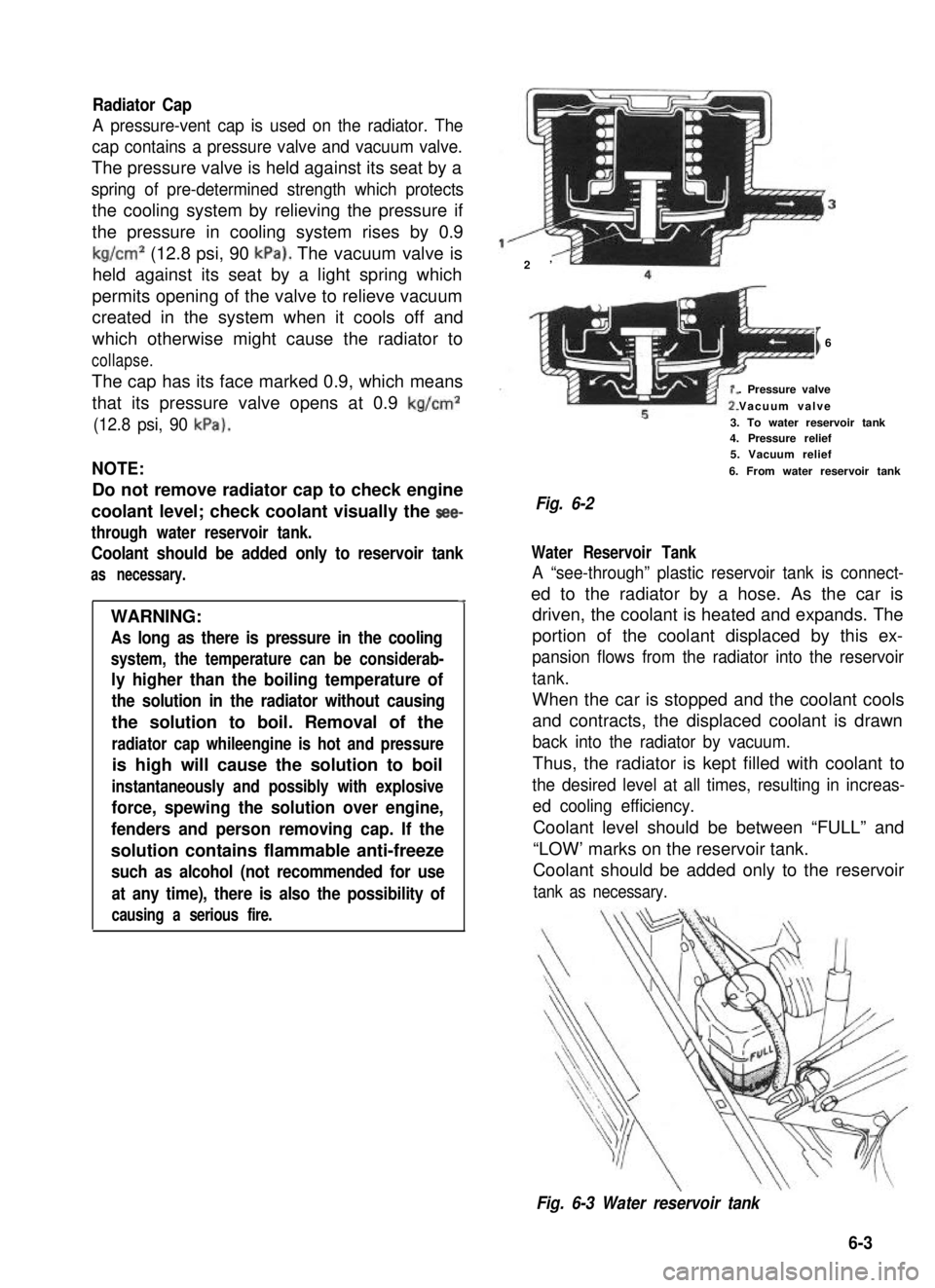
Radiator Cap
A pressure-vent cap is used on the radiator. The
cap contains a pressure valve and vacuum valve.
The pressure valve is held against its seat by a
spring of pre-determined strength which protects
the cooling system by relieving the pressure if
the pressure in cooling system rises by 0.9
kg/cm2 (12.8 psi, 90 kPa). The vacuum valve is
held against its seat by a light spring which
permits opening of the valve to relieve vacuum
created in the system when it cools off and
which otherwise might cause the radiator to
collapse.
The cap has its face marked 0.9, which means
that its pressure valve opens at 0.9 kg/cm2
(12.8 psi, 90 kPa).
NOTE:
Do not remove radiator cap to check engine
coolant level; check coolant visually the see-
through water reservoir tank.
Coolant should be added only to reservoir tank
as necessary.
4
WARNING:
As long as there is pressure in the cooling
system, the temperature can be considerab-
ly higher than the boiling temperature of
the solution in the radiator without causing
the solution to boil. Removal of the
radiator cap whileengine is hot and pressure
is high will cause the solution to boil
instantaneously and possibly with explosive
force, spewing the solution over engine,
fenders and person removing cap. If the
solution contains flammable anti-freeze
such as alcohol (not recommended for use
at any time), there is also the possibility of
causing a serious fire.
2’
I6
. Pressure valve
Vacuum valve
3. To water reservoir tank4. Pressure relief5. Vacuum relief
6. From water reservoir tank
Fig. 6-2
Water Reservoir Tank
A “see-through” plastic reservoir tank is connect-
ed to the radiator by a hose. As the car is
driven, the coolant is heated and expands. The
portion of the coolant displaced by this ex-
pansion flows from the radiator into the reservoir
tank.
When the car is stopped and the coolant cools
and contracts, the displaced coolant is drawn
back into the radiator by vacuum.
Thus, the radiator is kept filled with coolant to
the desired level at all times, resulting in increas-
ed cooling efficiency.
Coolant level should be between “FULL” and
“LOW’ marks on the reservoir tank.
Coolant should be added only to the reservoir
tank as necessary.
Fig. 6-3 Water reservoir tank
6-3
Page 194 of 962

Water Pump
The centrifugal type water pump is used in the
cooling system. The pump impeller is supported
by a totally sealed bearing. The water pump can
not be disassembled.
Fig. 6-4
Thermostat
A wax pellet type thermostat is used in the
coolant outlet passage to control the flow of
engine coolant, to provide fast engine warm up
and to regulate coolant temperatures.
A wax pellet element is hermetically contained
in a metal case, and expands when heated and
contracts when cooled.
When the pellet is heated and expands, the metal
case pushes down the valve to open it.
As the pellet is cooled, the contraction allows a
spring to close the valve.
Thus, the valve remains closed while the coolant
is cold, preventing circulation of coolant through
the radiator.
In the top portion of the thermostat, an air
bleed valve is provided; this valve is for venting
out the gas or air, if any, that is accumulated in
the circuit.
There are two types of thermostat, A and B, as
given below. Either one is used depending on
vehicle specifications. The temperature at which
the valve begins to open is stamped on each
thermostat. Be sure to note this stamped tempe-
rature for replacement.
IThermostat functional spec. f 1.5’C (2.7’F)I
IIThermostat “A” (Thermostat “B” 1
Temp. at which
valve begins to82°C (179’F)
open
BB’C (190°F)
Temp. at which
valve become
fully open
95% (203’F)1OO’C (212’F)
Valve liftMore thanMore than
8 mm at 95’C8 mm at 1OO’C
Fig. 6-5 Thermostat
1. Air bleed valve
At this point, coolant is allowed to circulate
only throughout the engine to warm it quickly
and evenly.
As the engine warms, the pellet expands and the
thermostat valve opens, permitting coolant to
flow through the radiator.
6-4
Page 195 of 962
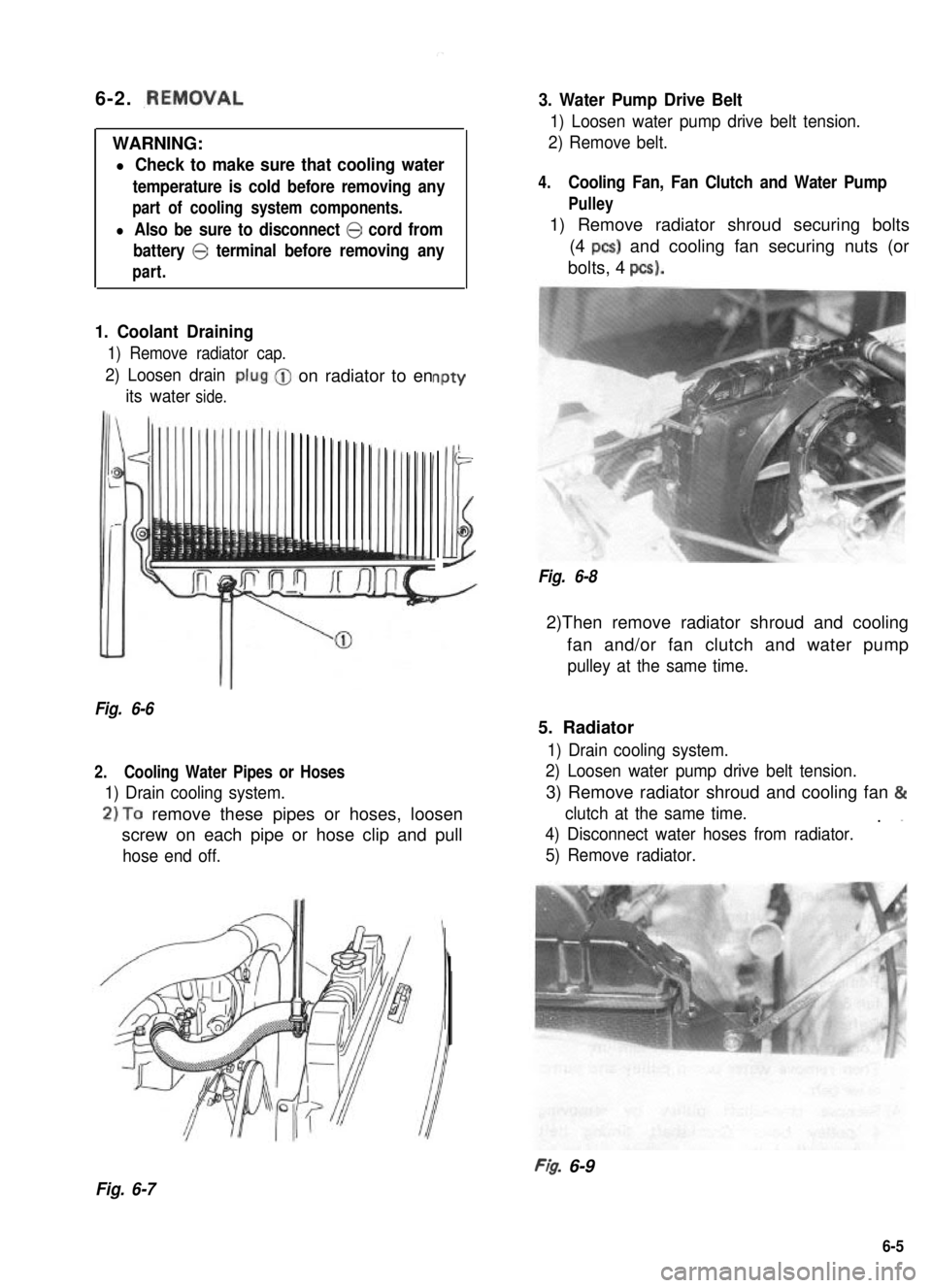
6-2. .REMOVAL
WARNING:
l Check to make sure that cooling water
temperature is cold before removing any
part of cooling system components.
l Also be sure to disconnect 0 cord from
battery 0 terminal before removing any
part.
1. Coolant Draining
1) Remove radiator cap.
2) Loosen drain
its waterside.
-on radiator to enPtY
-
Illi
Fig. 6-6
2.Cooling Water Pipes or Hoses
1) Drain cooling system.
2)To remove these pipes or hoses, loosen
screw on each pipe or hose clip and pull
hose end off.
3. Water Pump Drive Belt
1) Loosen water pump drive belt tension.
2) Remove belt.
4.Cooling Fan, Fan Clutch and Water Pump
Pulley
1) Remove radiator shroud securing bolts
(4 PCS) and cooling fan securing nuts (or
bolts, 4 pcs).
Fig. 6-8
2)Then remove radiator shroud and cooling
fan and/or fan clutch and water pump
pulley at the same time.
5. Radiator
1) Drain cooling system.
2) Loosen water pump drive belt tension.
3) Remove radiator shroud and cooling fan &
clutch at the same time.. ”
4) Disconnect water hoses from radiator.
5) Remove radiator.
FI& 6-9
Fig. 6-7
6-5
Page 198 of 962

Radiator
If the water side of the radiator is found exces-
sively rusted or covered with scales, clean it
by flushing with the radiator cleaner compound.
This flushing should be carried out at regular
intervals for scale or rust formation advances
with time even where a recommended type of
coolant is used. Periodical flushing will prove
more economical.
Inspect the radiator cores and straighten the
flattened or bent fins, if any. Clean the cores,
removing road grimes and trashes.
Excessive rust or scale formation on the wet side
of the radiator lowers the cooling efficiency.
Flattened or bent fins obstruct the flow of air
through the core to impede heat dissipation.
I
Radiator flushingTwo years
interval(recommended)I
Water Pump
NOTE:
Do not disassemble water pump.
If any repair is required on pump, replace it
as assembly.
l Rotate water pump by hand to check for
smooth operation.
If pump does not rotate smoothly or makes
an abnormal noise, replace it.
Fig. 6- 19
Fig. 6-18
Water Temperature Gauge
For gauge inspection, refer to SECTION 21
BODY ELECTRICAL EQUIPMENT of this
manual.
6-8
Page 201 of 962
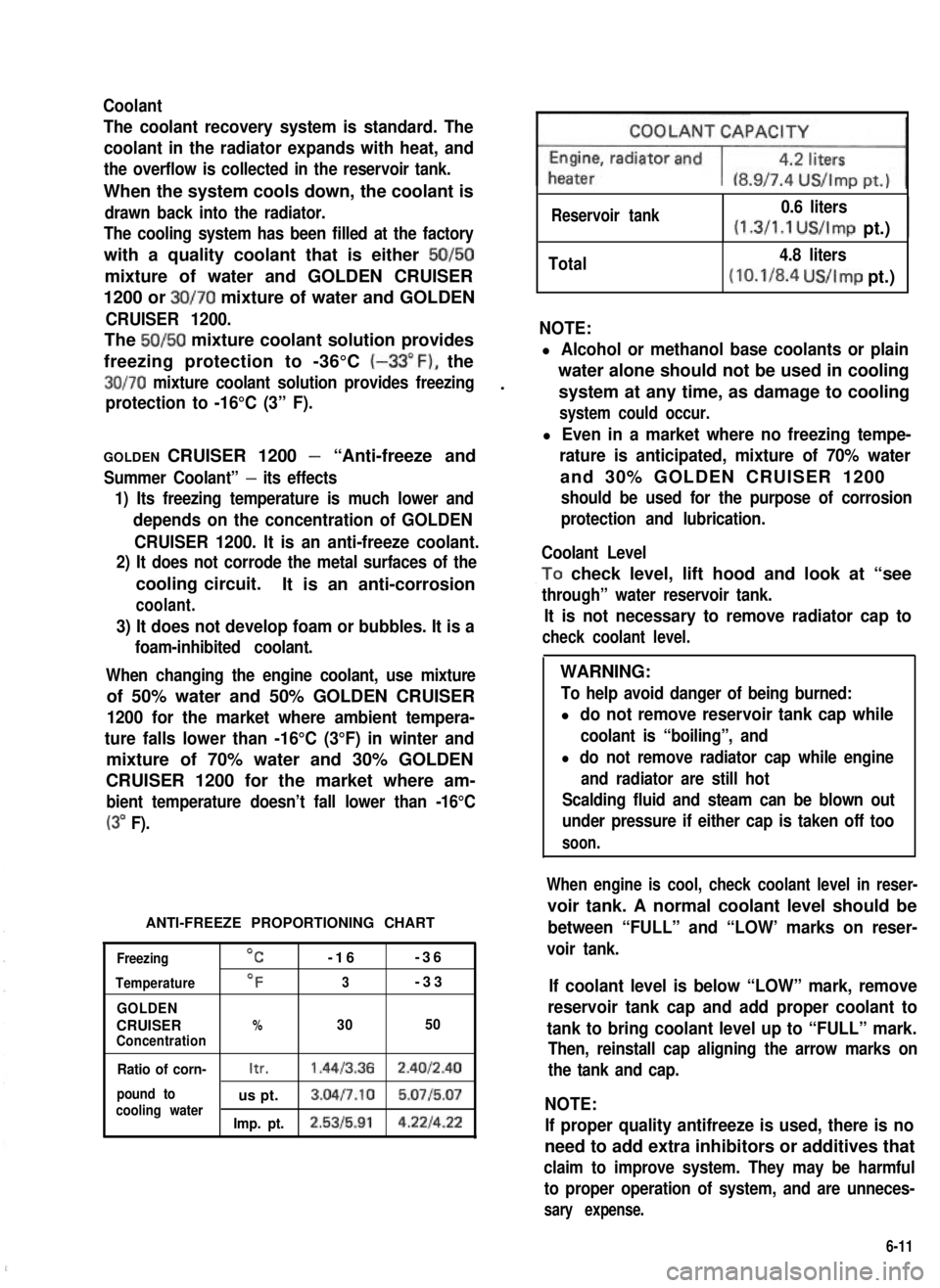
Coolant
The coolant recovery system is standard. The
coolant in the radiator expands with heat, and
the overflow is collected in the reservoir tank.
When the system cools down, the coolant is
drawn back into the radiator.
The cooling system has been filled at the factory
with a quality coolant that is either 50/50
mixture of water and GOLDEN CRUISER
1200 or 30/70 mixture of water and GOLDEN
CRUISER 1200.
The 50/50 mixture coolant solution provides
freezing protection to -36°C (-33”F), the
30/70 mixture coolant solution provides freezing.
protection to -16°C (3” F).
GOLDEN CRUISER 1200 - “Anti-freeze and
Summer Coolant” - its effects
1) Its freezing temperature is much lower and
depends on the concentration of GOLDEN
CRUISER 1200. It is an anti-freeze coolant.
2) It does not corrode the metal surfaces of the
cooling circuit.It is an anti-corrosion
coolant.
3) It does not develop foam or bubbles. It is a
foam-inhibited coolant.
When changing the engine coolant, use mixture
of 50% water and 50% GOLDEN CRUISER
1200 for the market where ambient tempera-
ture falls lower than -16°C (3°F) in winter and
mixture of 70% water and 30% GOLDEN
CRUISER 1200 for the market where am-
bient temperature doesn’t fall lower than -16°C
(3” F).
ANTI-FREEZE PROPORTIONING CHART
Freezing
Temperature
GOLDEN
CRUISERConcentration
OC-16-36
OF3-33
%3050
Ratio of corn-Itr.1.4413.362.4012.40
pound tous pt.3.04l7.10 5.0715.07cooling waterImp. pt.2.5315.914.221422
Reservoir tank0.6 liters
(1.3/1.1 US/Imp pt.)I
Total4.8 liters
(10.1/8.4 US/Imp pt.)
NOTE:
l Alcohol or methanol base coolants or plain
water alone should not be used in cooling
system at any time, as damage to cooling
system could occur.
l Even in a market where no freezing tempe-
rature is anticipated, mixture of 70% water
and 30% GOLDEN CRUISER 1200
should be used for the purpose of corrosion
protection and lubrication.
Coolant Level
,To check level, lift hood and look at “see
through” water reservoir tank.
It is not necessary to remove radiator cap to
check coolant level.
WARNING:
To help avoid danger of being burned:
l do not remove reservoir tank cap while
coolant is “boiling”, and
l do not remove radiator cap while engine
and radiator are still hot
Scalding fluid and steam can be blown out
under pressure if either cap is taken off too
soon.
When engine is cool, check coolant level in reser-
voir tank. A normal coolant level should be
between “FULL” and “LOW’ marks on reser-
voir tank.
If coolant level is below “LOW” mark, remove
reservoir tank cap and add proper coolant to
tank to bring coolant level up to “FULL” mark.
Then, reinstall cap aligning the arrow marks on
the tank and cap.
NOTE:
If proper quality antifreeze is used, there is no
need to add extra inhibitors or additives that
claim to improve system. They may be harmful
to proper operation of system, and are unneces-
sary expense.
6-11
Page 458 of 962
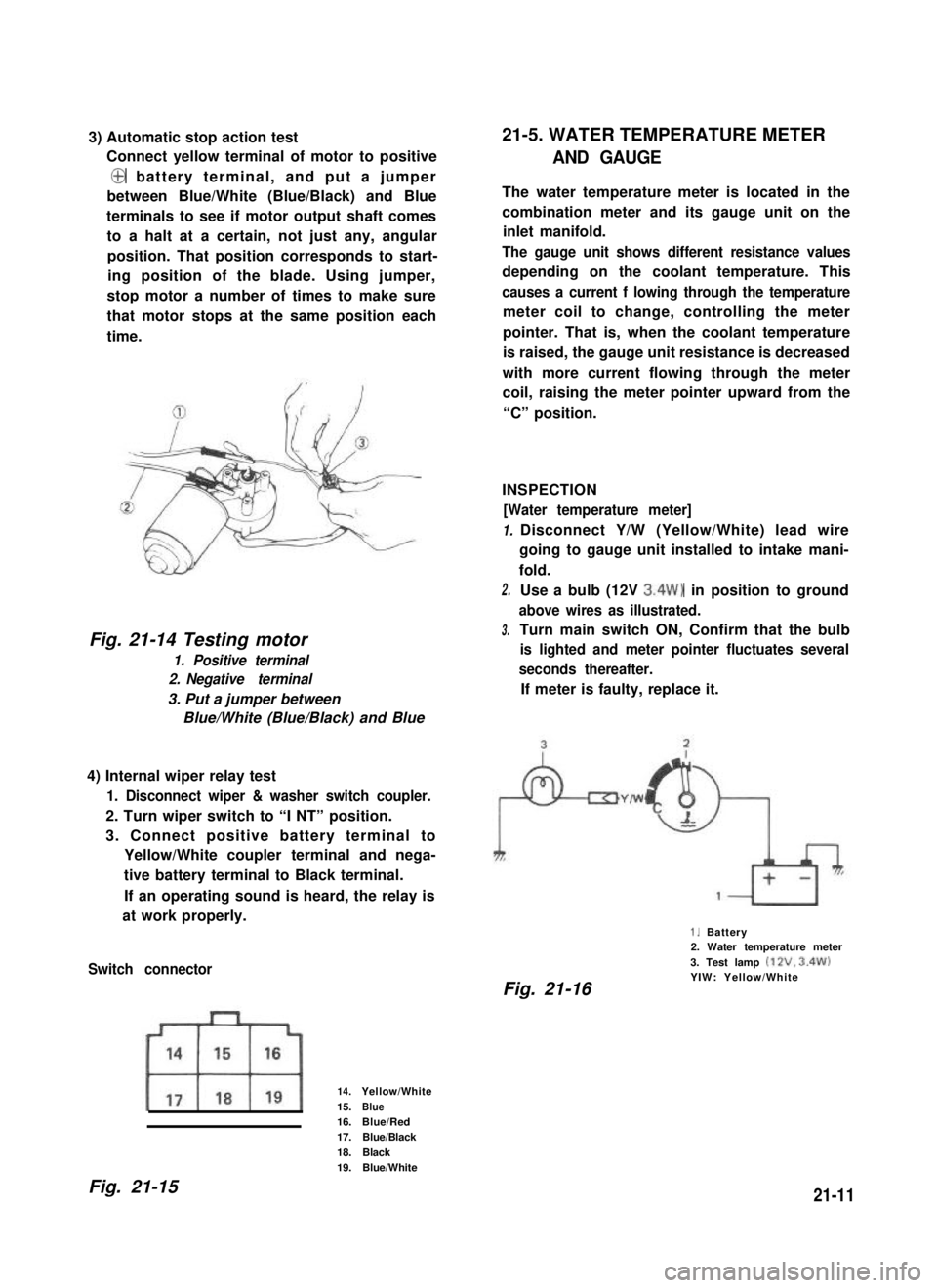
3) Automatic stop action test
Connect yellow terminal of motor to positive
@ battery terminal, and put a jumper
between Blue/White (Blue/Black) and Blue
terminals to see if motor output shaft comes
to a halt at a certain, not just any, angular
position. That position corresponds to start-
ing position of the blade. Using jumper,
stop motor a number of times to make sure
that motor stops at the same position each
time.
Fig. 21-14 Testing motor
1. Positive terminal
2. Negative terminal
3. Put a jumper between
Blue/White (Blue/Black) and Blue
4) Internal wiper relay test
1. Disconnect wiper & washer switch coupler.
2. Turn wiper switch to “I NT” position.
3. Connect positive battery terminal to
Yellow/White coupler terminal and nega-
tive battery terminal to Black terminal.
If an operating sound is heard, the relay is
at work properly.
Switch connector
14.Yellow/White
15.Blue16.Blue/Red17.Blue/Black
18.Black19.Blue/White
21-5. WATER TEMPERATURE METER
AND GAUGE
The water temperature meter is located in the
combination meter and its gauge unit on the
inlet manifold.
The gauge unit shows different resistance values
depending on the coolant temperature. This
causes a current f lowing through the temperature
meter coil to change, controlling the meter
pointer. That is, when the coolant temperature
is raised, the gauge unit resistance is decreased
with more current flowing through the meter
coil, raising the meter pointer upward from the
“C” position.
INSPECTION
[Water temperature meter]
1.
2.
3.
Disconnect Y/W (Yellow/White) lead wire
going to gauge unit installed to intake mani-
fold.
Use a bulb (12V 3.4W) in position to ground
above wires as illustrated.
Turn main switch ON, Confirm that the bulb
is lighted and meter pointer fluctuates several
seconds thereafter.
If meter is faulty, replace it.
1. Battery2. Water temperature meter
3. Test lamp (12V. 3.4W)YIW: Yellow/WhiteFig. 21-16
Fig. 21-1521-11